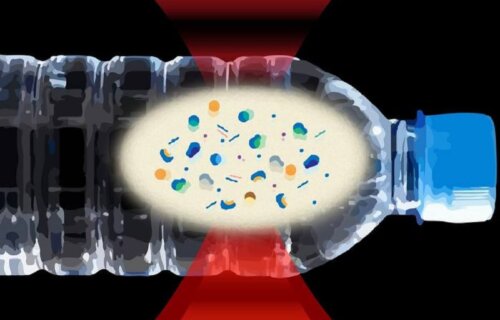NEW YORK — A single bottle of water can contain hundreds of thousands of microscopic plastic particles, potentially posing serious health risks for drinkers, researchers warn. Scientists at Columbia University caution that these nanoplastics, which form as plastics break down into increasingly smaller pieces, can infiltrate vital organs. Consumed daily by people worldwide, their tiny size allows them to penetrate our bodies, reaching the bloodstream and even individual cells.
Nanoplastics can enter our bodies through the lungs or intestines and then travel to various organs, including the heart and brain. Alarmingly, they can also cross the placenta, affecting unborn babies. This concern led a team of researchers to investigate further.
In their study, the scientists analyzed three popular bottled water brands in the United States. They employed advanced lasers to detect plastic particles as small as 100 nanometers – for comparison, a human hair is about 100,000 nanometers wide.
Their findings reveal an average of 240,000 tiny plastic particles per liter of bottled water, a figure 100 times higher than some previous estimates. Of these, 90 percent were nanoplastics, and 10 percent were microplastics. Commonly found nanoplastics included polyethylene terephthalate (PET), a typical substance used in making water bottles, and polyamide, likely originating from the plastic filters used in water purification.
“Previously this was just a dark area, uncharted. Toxicity studies were just guessing what’s in there,” says study co-author Beizhan Yan, an environmental chemist at Columbia University’s Lamont-Doherty Earth Observatory, in a media release. “This opens a window where we can look into a world that was not exposed to us before.”

Other plastics detected were polystyrene, polyvinyl chloride, and polymethyl methacrylate, all used in various industrial processes. Concerningly, these identified plastics comprised only about 10 percent of all the nanoparticles in the samples, leaving the composition of the remaining 90 percent unknown.
Most plastics do not degrade into harmless substances. Instead, they continually break down into smaller particles of the same chemical composition. This ongoing division makes it challenging to determine the exact number of nanoplastics in any given environment.
The Columbia team aims to use their findings to explore the presence of nanoplastics in other areas, such as tap water and wastewater from laundry, which has shown to contain millions of particles per laundry load.
This study emerges as global plastic production, amounting to 400 million metric tons annually, continues to impact the environment. Over 30 million tons of plastic are discarded each year in waterways and on land. As synthetic materials like clothing shed plastic particles during use, experts are still assessing the potential health effects on humans.
“It’s not size that matters. It’s the numbers, because the smaller things are, the more easily they can get inside us,” concludes study co-author Wei Min, a Columbia biophysicist.
The research is published in the journal Proceedings of the National Academy of Sciences.
You might also be interested in:
- Egg whites remove nearly 100% of microplastics from water, Princeton researchers discover
- Water left over in your reusable plastic bottle? Here’s why you shouldn’t drink it.
- Shocking survey reveals people still use an 18-story mountain of plastic each year
South West News Service writer Imogen Howse contributed to this report.

Time to go back to glass: like in the 1950’s.😊
What about the water inside it? Most of it already has plastics in it, but also a lot of other unmeasureable chemicals. Solvents and organic molecules … not organic in a good way either.
I have been getting sick from the water for awhile and I didn’t know if it was tap or bottle
I noticed the bottle water gives me headache, stomach pain etc
I tried to tell people years ago noone listened
Where can I either get water w/o all this plastic in it, or where can I find a filter that will remove it. And that is not even considering all the pollutants and solvents and other things in our water.
I feel like in some ways we have to start over – but we cannot just scrap everything. All the money and financial empires the super-rich have created, they created by ruining the environment and our health … and their own health tool.
It’s like if you cannot see it in the air, or water or land or in your body, you can’t prove it and it’s not there.
To fix it all the huge dynasties and corporations need to use their wealth to pay to get this fixed. This is disgusting, because we are all victims or this idiocy.
Maybe in thousands or millions of years and alien species will land on Earth and they only thing they will find left from humans is lots of plastic particles all over the planet.